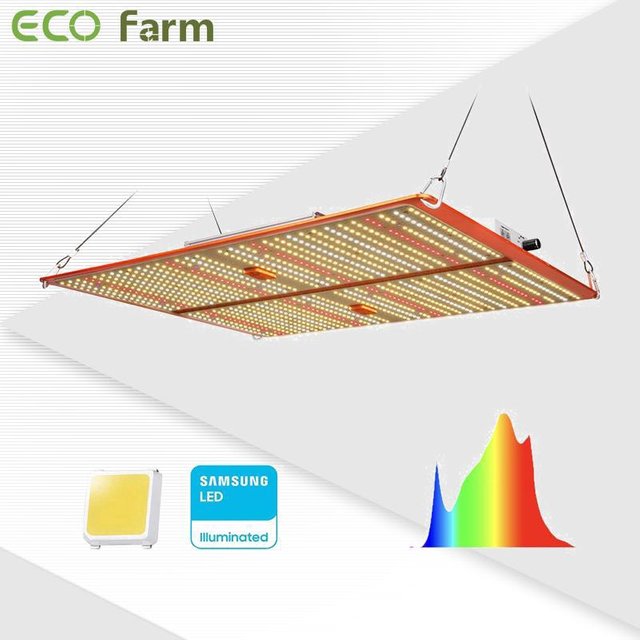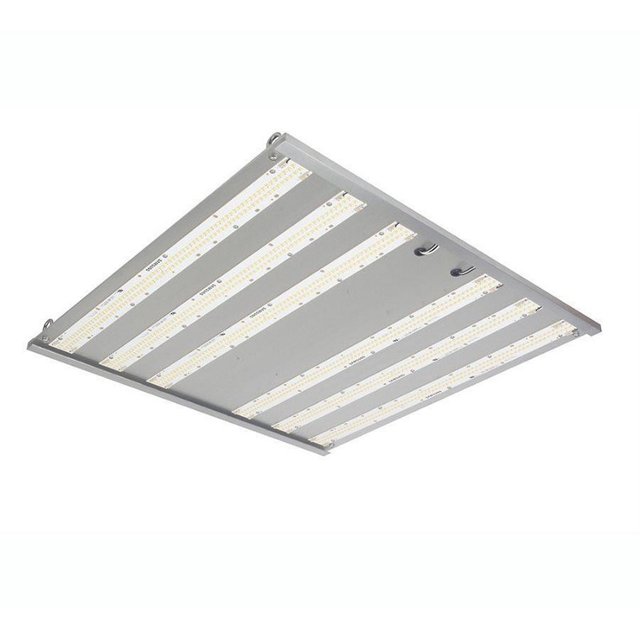In this article, we’ll take a look at the best LED grow lights on the market to start the 2022 school year! We have selected the most important criteria for indoor growing. We have selected the most efficient LED grow lights. With these products, you will achieve excellent cultivation results for high-quality plants with large flowers.
How do you use grow lights on indoor plants?
In general, most flowering plants and vegetables need 12 to 16 hours of light per day, and flowering plants (usually houseplants) need it the most. That said, an important part of a plant’s growth cycle is darkness, so while you can technically expose your houseplants to growing light 24/7, they won’t benefit from every aspect of the growth cycle. Most plants do need about 8 hours of darkness per day to take full advantage of their potential growth cycle. On top of that, having your lights on 24/7 isn’t energy efficient, so if you want the healthiest plants, it’s best to follow the guidelines.
ECO Farm ECOT 480W Dimmable Samsung LM301H Quantum board LED Grow Light
Features:
ECO Farm Grow lights utilize the latest in high yielding LEDs technology today-Samsung LM301H diodes, high Energy Efficiency with 2.8 umol/J, make you get 30% higher yield compare OLD blurple led lights; Max 2.0g yield per wattage (power draw), achieve maximum quality and quantity, much better than traditional HPS grow systems. Only consumes 120w, running 50% less power than the HPS or other SMD LEDs or Blurple lamps.The grow light can be adjusted the light intensity at liberty. Multi-light Connection with unified dimming especially beneficial for large area of indoor growing and commercial planting. It is idea for all growth stages, excellent full spectrum- white, blue, red and IR (3000K, 5000K, 660nm and IR 760nm & 395nm UV). 3000K diodes providing more reddish light and the 5000K providing more blueish. The 660nm red and IR light is especially useful during bloom, where it speeds up flowering time and boost yields.
Features:
The Equinox 1000 utilizes the latest LED technology available from Samsung to deliver an impressive light output of 1057μmol/s. Drawing only 480 watts this light offers a 56% energy reduction when replacing a 1000W HPS light. The rugged workhorse design makes this fixture the obvious choice for growers seeking a high production and low energy lighting solution. The rugged high-grade aluminium design ensures this fixture can be utilized in tough working environments with minimal risk of damage.
How to Choose the Best Full-Spectrum Grow Lights?
Purchasing grow lights is not always a walk in the park. If you want more information on growth light specifications, you’ve come to the right place. The following buying guide covers everything you need to know before you set out to find grow lights for your operation.
Spectrum
Light spectrum is yet another key factor concept that you need to understand before you select the right grow light. A qualifying light needs to offer a full spectrum of light colors to promote photosynthesis (chlorophyll absorption).
Most growing experts recommend a full-spectrum fixture that offers a ratio of blue and red light as well as some UB and far-right radiation (photomorphogenesis. This spectrum usually covers the full photosynthetically active radiation range (PAR) or 400 to 700 nanometers.
Virtually every stage of the plant life cycle is dependent on targeted light wavelengths. This includes fruiting potential, flowering yield, vegetation growth, root growth, harvest characteristics, and harvest yield.
Blue light, which also falls within the 100 to 400-nanometer range, can determine the vegetation development, root development, and flower development of plants grown indoors. Meanwhile, red light (600 to 700 nanometers) improves plants’ photosynthesis and biomass. The UV wavelength, which ranges from 100 to 400 nanometers, is responsible for flavor and photosynthesis.
Most plants come with a recommended blue to red ratio. For example, lettuce fairs best with a 35:65 blue to red ratio. Meanwhile, tomatoes turn out best when they are exposed to a 5:1 ratio of red and blue.
Some growers think of light spectrum ratios as an element of plant design. When you understand the impact of light spectrum ratios on your plants, you can easily make changes to determine the outcome of your harvests.
Wattage
One of a grow light’s most important performance specs happens to be power consumption. This is the amount of wattage that your fixture draws from the outlet. The diodes that are built into LED lights are capable of producing intense light with small amounts of electricity.
Of course, wattage is also used to measure the amount of power that a fixture produces. Oftentimes, a manufacturer’s reported light output is higher than its reported wattage draw. When it comes to LEDs, there is often an exaggerated difference between these numbers. For example, the KingLED Reflector Series LED Grow Light mentioned above is described as having a 3,000-watt output and a 615-watt draw.
While you might be eager to save a buck on your electricity bill, LED lights with low electricity consumption are not always as promising as they appear. Oftentimes the lower power equates to lower production. If your fixture isn’t capable of producing enough PPFD, then it’s not going to help grow plants efficiently.
Most growers like to have a good idea of how many watts of electricity they’re using per square foot of grow space. This helps them to calculate their overall electricity expenditure. A draw of 20 to 50 watts per square foot is standard. You can use this calculator to determine how many watts of power your lights will use per square foot.
Coverage
Another essential consideration is growing space coverage. You need to be able to calculate the amount of growing space that your fixture can support. This number varies from grower to grower. After all, some people are managing large warehouses, while others boast 4-by-4 grow tents.
Generally speaking, lights with higher wattages are capable of covering larger areas. You will need to consider a light’s wattage, coverage area, and distance from plants before you can determine how many lights you need for your growing space.
Take into account that you may need to raise or lower your lights during different growing spaces. Raising and lowering plants alters a light’s overall PAR per square foot.
Cooling
While LED grows lights do not get nearly as hot as traditional light fixtures, they still produce excess heat. Most lights have a combination of onboard heat sinks, radiators, and fans that help them to maintain a reasonable temperature.
Without a reliable grow system, you risk exposing your plants to excess heat and dryness. The heat that is produced by LEDs has nowhere to go inside a grow room or tent. As such, it is automatically absorbed by the plants and other objects in a growing area. Grow rooms should be well ventilated. The temperature inside the room should fall somewhere between 70 and 85 degrees Fahrenheit when the lights are on.
You can calculate a grow light’s estimated heat production by multiplying the number of watts used by 3.41. This gives you the fixture’s heat production in BTUs (British thermal units.) You can also check out this online calculator to determine the total BTUs of cooling needed for an LED light.
Controls
Lights with built-in or remote controls give you the freedom of programming. You may be able to set a timer, adjust the red, blue ratio of your light, or alter a light’s intensity to better suit your growing needs at any given time.
Included Accessories
If you’re setting up a grow room for the first time, you’re going to need a good amount of accessories to complete your installation. Consider it a bonus if a manufacturer includes ratchets, hooks, and/or other hardware with their grow lights.
Conclusion
We hope this resource helped you decide which LED grow light is right for your indoor garden. When all the information is in one place, the advantages become very clear. We don’t want anyone making decisions based on outdated information or sticking with yesterday’s technology just because they don’t know new things.

